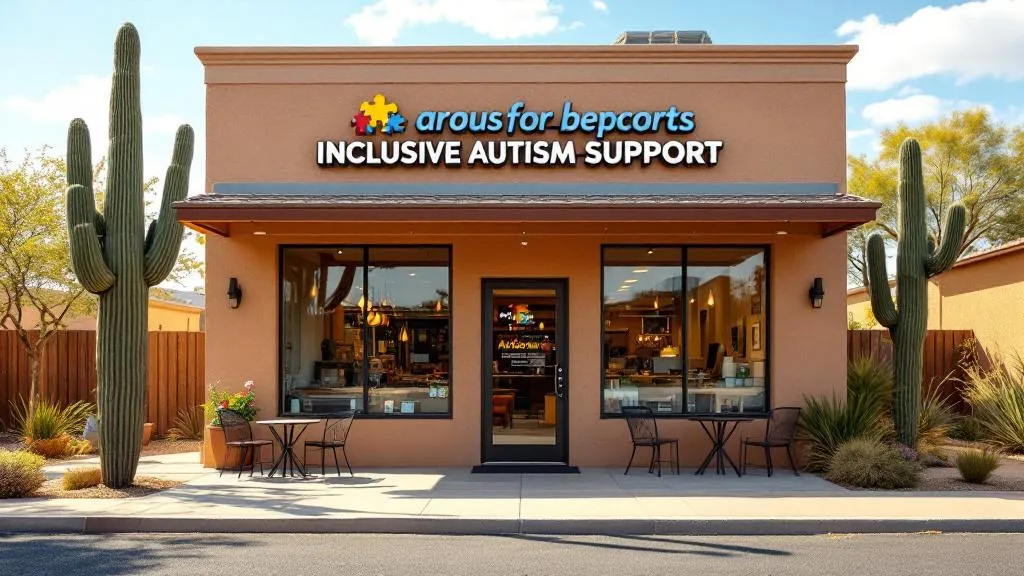What is stimulus fading in ABA
Understanding Stimulus Fading: A Key Technique in ABA

Introduction to Stimulus Fading in Applied Behavior Analysis
Stimulus fading is a fundamental technique used within Applied Behavior Analysis (ABA) to facilitate learning, promote independence, and transfer stimulus control from prompts to natural stimuli. This article explores the definition, applications, procedures, and research backing stimulus fading, demonstrating its importance in behavioral interventions across diverse settings.
Defining Stimulus Fading and Its Role in ABA
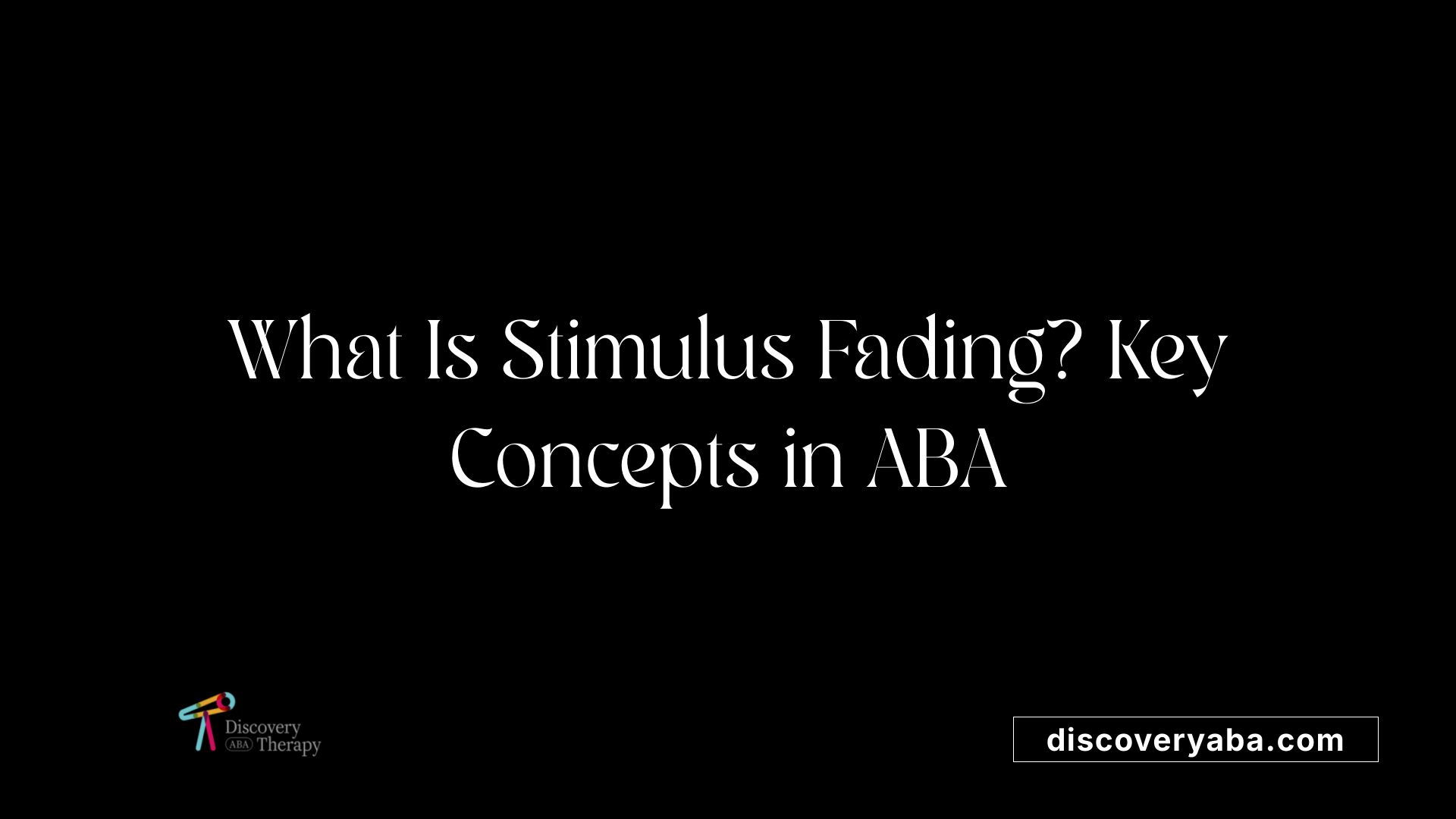
What is stimulus fading in ABA and how does it promote skill acquisition?
Stimulus fading in ABA (Applied Behavior Analysis) is a systematic technique used to help individuals learn new skills or modify behaviors by gradually changing the prominence or characteristics of a stimulus. This process starts with making the stimulus more noticeable or exaggerated, such as bright colors, large sizes, or prominent features, to capture the learner's attention and facilitate initial responses.
As the learner becomes more proficient, the stimulus's features are gradually diminished or faded. For example, a teacher might start with a brightly colored card to help a student identify a correct answer, and then slowly decrease the brightness as the student's response accuracy improves. Similarly, in teaching discrimination tasks, a stimulus may initially be presented in an exaggerated form—like a large shape or a prominent sound—and reduced over time.
This gradual removal or reduction of stimulus features helps transfer control from prompts or highly salient cues to more natural stimuli that are less exaggerated. Through this process, responses become more independent of external cues, encouraging the learner to respond correctly to the actual, everyday stimuli.
Stimulus fading supports skill acquisition by promoting generalization—the ability to apply learned responses across various settings and stimuli. It also reduces dependency on external cues, fostering confidence and autonomy. Over time, learners are able to respond appropriately even when the prompt or exaggerated stimulus is no longer present.
In essence, stimulus fading is fundamental in encouraging durable learning. It ensures that individuals do not become overly reliant on prompts or heightened cues, thereby enhancing their ability to perform skills independently in natural environments.
Applications and Techniques of Stimulus Fading in Behavioral Interventions
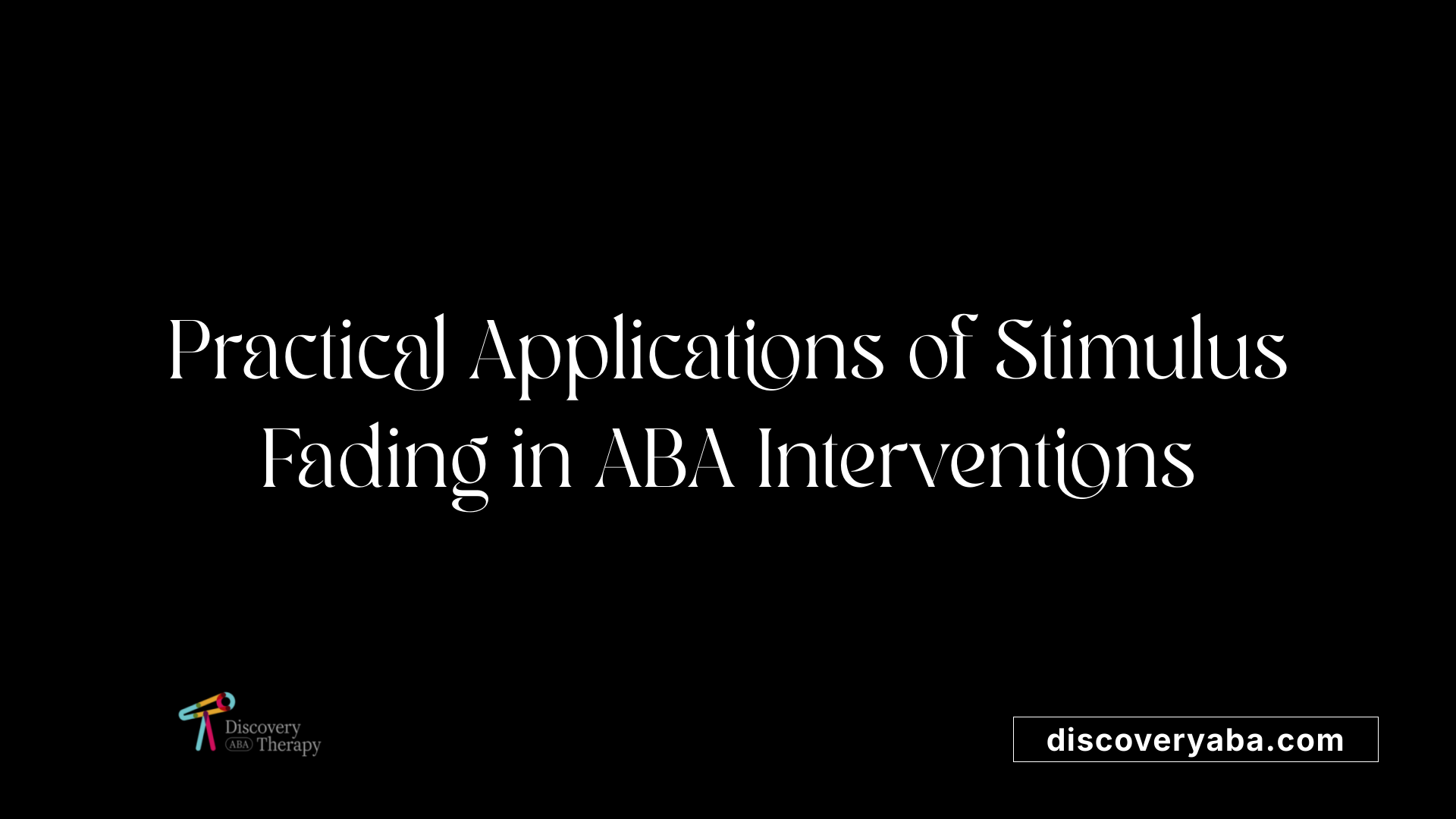 Stimulus fading is a versatile technique widely used in Applied Behavior Analysis (ABA) to promote learning and reduce maladaptive behaviors. It involves the systematic modification of stimuli to transfer control from a dominant or distracting stimulus to a more natural or appropriate one.
Stimulus fading is a versatile technique widely used in Applied Behavior Analysis (ABA) to promote learning and reduce maladaptive behaviors. It involves the systematic modification of stimuli to transfer control from a dominant or distracting stimulus to a more natural or appropriate one.
One common application is in discrimination tasks, such as teaching children to distinguish between different objects, colors, or sounds. For example, initially emphasizing a certain color with bright or large stimuli helps the learner respond correctly. Over time, the size, brightness, or prominence of the stimulus is gradually reduced until the child can discriminate without dependency on exaggerated features.
Stimulus fading is also crucial in increasing food acceptance, especially for children with feeding challenges or autism. Therapists may start by blending non-preferred foods with preferred ones or modifying textures, then progressively increasing the non-preferred component or changing the texture until acceptance occurs naturally.
Another significant use is in exposure therapy for anxiety and phobias. Gradually approaching a feared stimulus, such as a spider or a social situation, while reinforcing calm responses, facilitates habituation. The stimulus is systematically faded in intensity or proximity, helping individuals respond more comfortably over time.
Procedures involve various methods of altering stimulus features:
- Increasing or decreasing the intensity or size of visual cues.
- Morphing or transforming the shape or characteristics of stimuli.
- Delaying cues to encourage responses to natural stimuli.
For example, in teaching a child to identify a toy, a teacher might begin with a brightly colored card and gradually fade the color or size as the child demonstrates correct responses. Similarly, in ABA teaching, a learner might initially respond to physical prompts, such as touching a hand, which are then systematically reduced through prompt fading.
An illustrative case is during training to differentiate between a fork and a spoon, where initially the fork is larger and more prominent; over sessions, the size and prominence are gradually reduced, enabling the learner to distinguish based on subtle cues.
Additionally, stimulus fading can involve transforming stimulus shape or features, such as changing a shape from an exaggerated form to a standard one, or gradually lightening the color of a visual prompt.
The goal across all these applications is to maintain correct responses while reducing reliance on external cues. This promotes generalization, independence, and the ability to respond correctly in natural settings.
| Application Area | Stimulus Modality | Fading Technique | Purpose | Example |
|---|---|---|---|---|
| Discrimination Learning | Visual, Auditory | Size, Intensity, Color, Shape | To promote independent discrimination | From large, bright objects to standard-sized, natural stimuli |
| Food Acceptance | Texture, Color | Blending, Texture modification | Increase acceptance of non-preferred foods | Gradual removal of blending as acceptance improves |
| Exposure Therapy | Visual, Tactile | Proximity, Intensity | Reduce fear responses | Approaching a feared object gradually |
| Skills Teaching | Physical prompts, Visual cues | Prompts reduction, Stimulus transformation | Promote independence | Fading physical assistance in tasks |
Stimulus fading is closely integrated with prompt fading techniques such as prompt delay and stimulus control transfer. These methods collectively help individuals respond more independently by gradually removing supports. For example, prompt fading involves reducing physical or verbal prompts step-by-step, while stimulus fading focuses on the stimuli themselves.
In summary, stimulus fading is an essential technique in ABA that supports skill development, promotes independence, and reduces maladaptive behaviors through systematic and gradual stimulus modifications. Its applications span from discrete skill training to anxiety and feeding interventions, making it a fundamental tool in behavior analysis.
Practical Strategies for Implementing Stimulus Fading
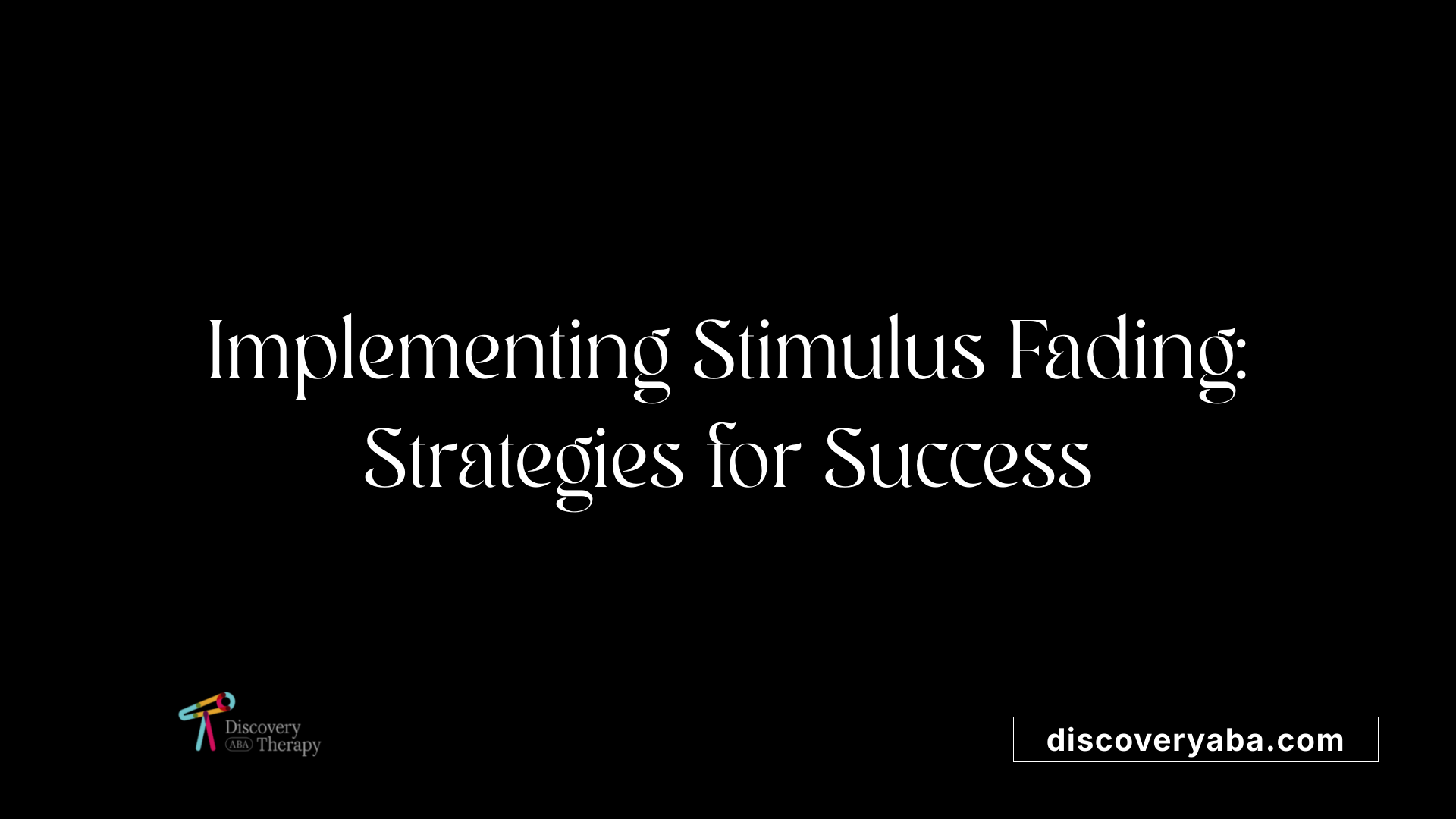 In applied behavior analysis (ABA), stimulus fading is a useful technique for helping learners develop independence by systematically reducing cues or prompts. Practical examples include gradually lightening the brightness of a visual cue, such as a brightly colored card, to help a student identify a correct answer. Over time, the vividness of the stimulus is faded, encouraging the student to respond based on the stimulus's inherent features rather than external aids.
In applied behavior analysis (ABA), stimulus fading is a useful technique for helping learners develop independence by systematically reducing cues or prompts. Practical examples include gradually lightening the brightness of a visual cue, such as a brightly colored card, to help a student identify a correct answer. Over time, the vividness of the stimulus is faded, encouraging the student to respond based on the stimulus's inherent features rather than external aids.
Another common application is in exposure therapy for childhood fears or selective mutism. Clinicians may start by presenting a feared object or situation at a lower intensity or distance and then gradually approach or increase the exposure. For instance, if a child fears a specific toy, the therapist might first show the toy from afar with minimal interaction, then gradually bring it closer, fostering habituation and encouraging response.
When it comes to stimuli such as size, brightness, or prominence, strategies involve methodically decreasing these features. For example, a teacher might use a large, vivid visual prompt to guide a child's behavior, then slowly reduce its size or change it to a less conspicuous version. This can include fading from large, colorful signs to smaller, monochrome cues, helping the learner respond to subtler stimuli.
These systematic adjustments help transfer stimulus control from exaggerated or artificial cues to more natural or everyday stimuli, promoting generalization of skills. In language training, prompts like physical gestures or verbal cues can be gradually faded out, allowing the child to respond independently to less salient signals. In feeding disorders, modifying food textures gradually increases acceptance, illustrating stimulus fading applied to non-visual stimuli.
Overall, the success of stimulus fading relies on consistent, measured changes, often decreasing one feature at a time, such as size, intensity, or salience. By doing so, learners become less dependent on prompts and cues, leading to more autonomous behaviors. Proper planning, ongoing evaluation, and patience are essential for effectively implementing these techniques, ultimately fostering skill acquisition, reducing maladaptive dependence on external stimuli, and encouraging natural responses in varied environments.
Difference Between Stimulus Shaping, Transformation, and Fading
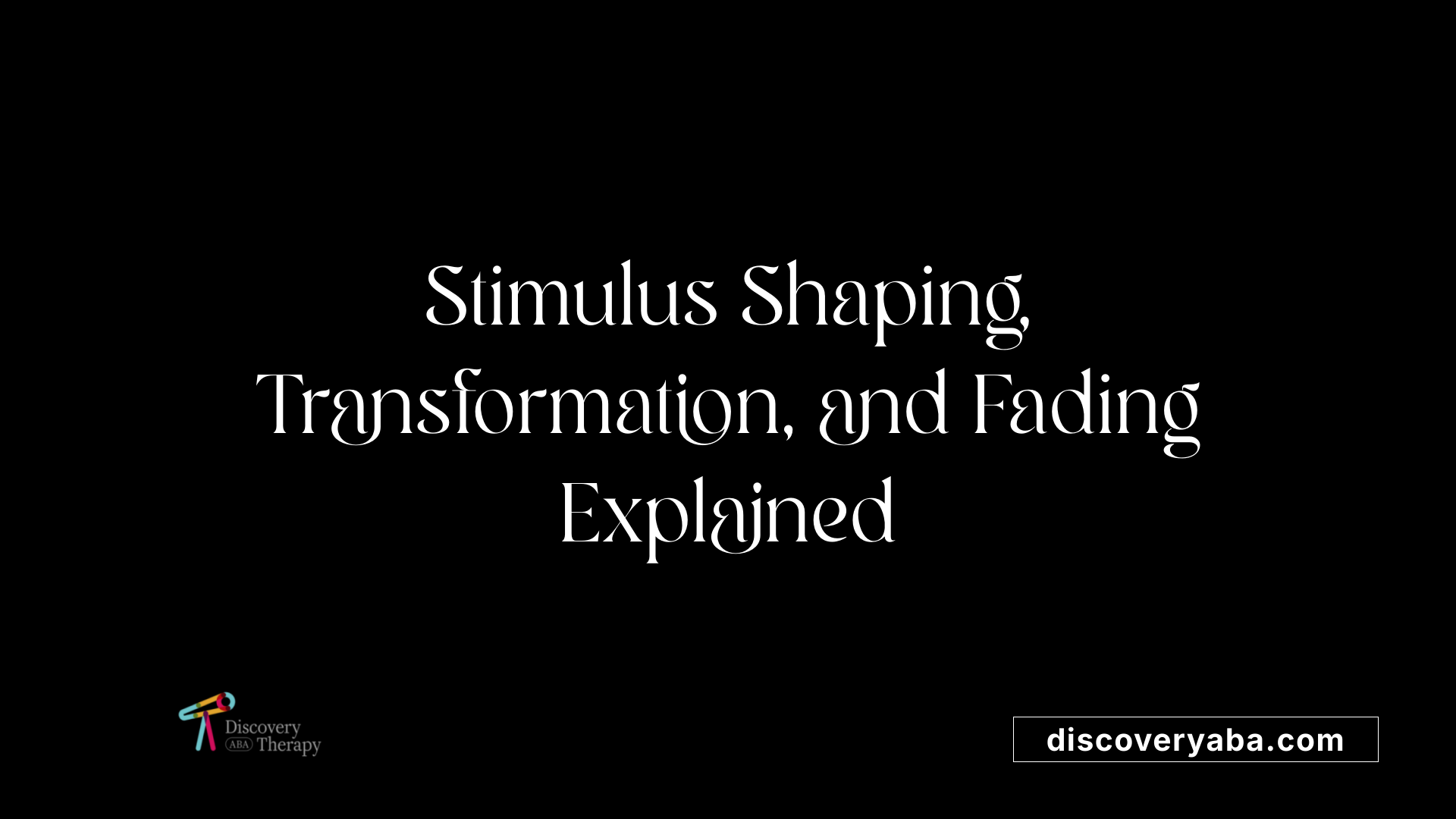
What is the difference between stimulus shaping, stimulus shape transformation, and stimulus fading?
Stimulus shaping, transformation, and fading are distinct yet interrelated techniques used in Applied Behavior Analysis (ABA) to facilitate learning and promote generalization of skills.
Stimulus shaping involves gradually modifying the features of a stimulus to make it more similar to the natural or target stimulus. This approach helps learners respond correctly without becoming overly dependent on prompts. For example, a teacher may start with a brightly colored card and slowly fade the brightness as the student becomes more proficient, encouraging independent recognition.
In contrast, stimulus shape transformation creates exaggerated or altered versions of stimuli to serve as prompts or cues. These modified stimuli are deliberately different to help the learner distinguish and respond appropriately. An example could be using a large, abstract shape to prompt a response, which is then gradually transformed into the actual shape needed.
Stimulus fading, on the other hand, involves the systematic reduction or removal of prompts or artificial stimuli that guide the response. The goal is to transfer control of the behavior from the prompt to the natural stimulus in the environment. For instance, a teacher might initially use a brightly colored sign to prompt a behavior and then progressively fade the color intensity until the learner responds to the natural cue.
How does each method facilitate stimulus control and skill generalization?
All three strategies aim to shift stimulus control from artificial or prompting cues to natural stimuli, fostering skill independence.
Stimulus shaping enhances the learner's ability to respond to real-world stimuli by gradually adjusting stimulus features, thereby reducing dependency on artificial cues.
Shape transformation helps in discriminating stimuli that might initially appear very different from the natural stimuli through exaggerated versions or transformations, making initial learning easier.
Fading of prompts ensures that responses are maintained in diverse settings without reliance on external cues, supporting generalization.
Together, these techniques promote flexible, adaptable responding, enabling individuals to transfer learned behaviors across various contexts and stimuli, ultimately leading to greater independence.
Research Evidence Supporting Stimulus Fading in ABA
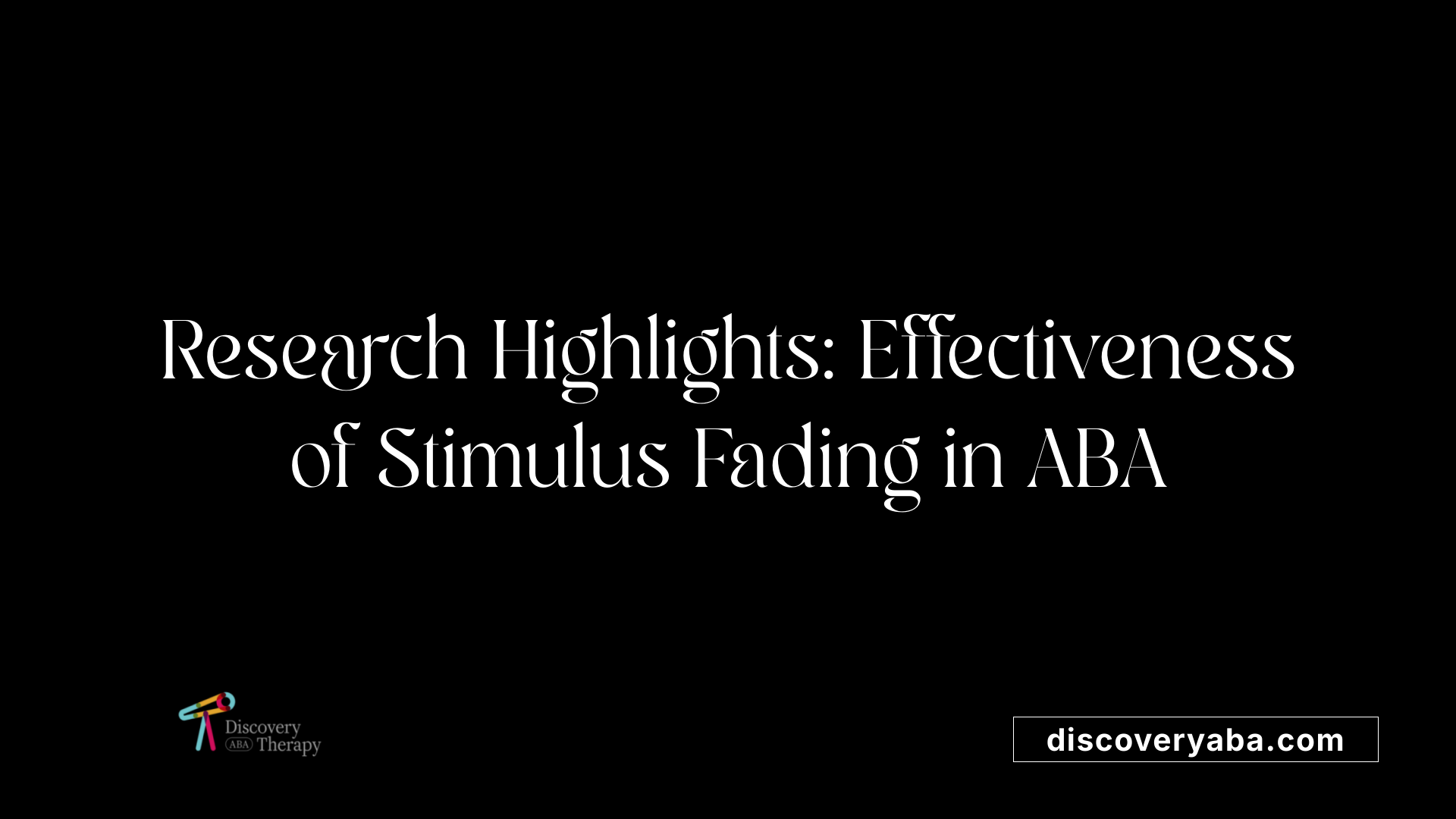
What does research say about the effectiveness of stimulus fading in ABA?
Research consistently supports the use of stimulus fading as an effective intervention in Applied Behavior Analysis (ABA). Numerous studies have demonstrated its success in teaching new skills, fostering independence, and reducing problematic behaviors across a wide range of settings.
Stimulus fading has been shown to facilitate response elaboration, especially in communication and discrimination tasks. For example, studies involving children with autism have used stimulus fading to shape responses, transfer stimulus control, and promote skill generalization. These studies highlight how gradually altering stimulus features—such as size, intensity, or form—helps learners respond appropriately without relying on prompts.
In addition, stimulus fading is effective in reducing food refusal and treating phobias by slowly exposing individuals to feared stimuli in a controlled manner. This gradual approach promotes habituation and helps individuals overcome fears or hesitations, resulting in increased acceptance and adaptive behaviors.
The technique is often combined with differential reinforcement, which reinforces desired responses and accelerates learning. Evidence shows that such combined methods can improve outcomes, especially when quick progress is desired or when skill maintenance is critical.
While stimulus fading can be time-consuming and requires systematic planning, the research underlines its versatility. It is applicable in naturalistic settings, including homes, schools, and clinics, making it an accessible tool for diverse populations and behaviors.
Overall, studies validate stimulus fading as a reliable, evidence-based strategy that enhances skill acquisition, reduces problematic behaviors, and supports behavioral flexibility. Its broad applicability and strong empirical support make it a fundamental component of ABA interventions.
The Significance of Stimulus Fading for Behavior Change and Generalization
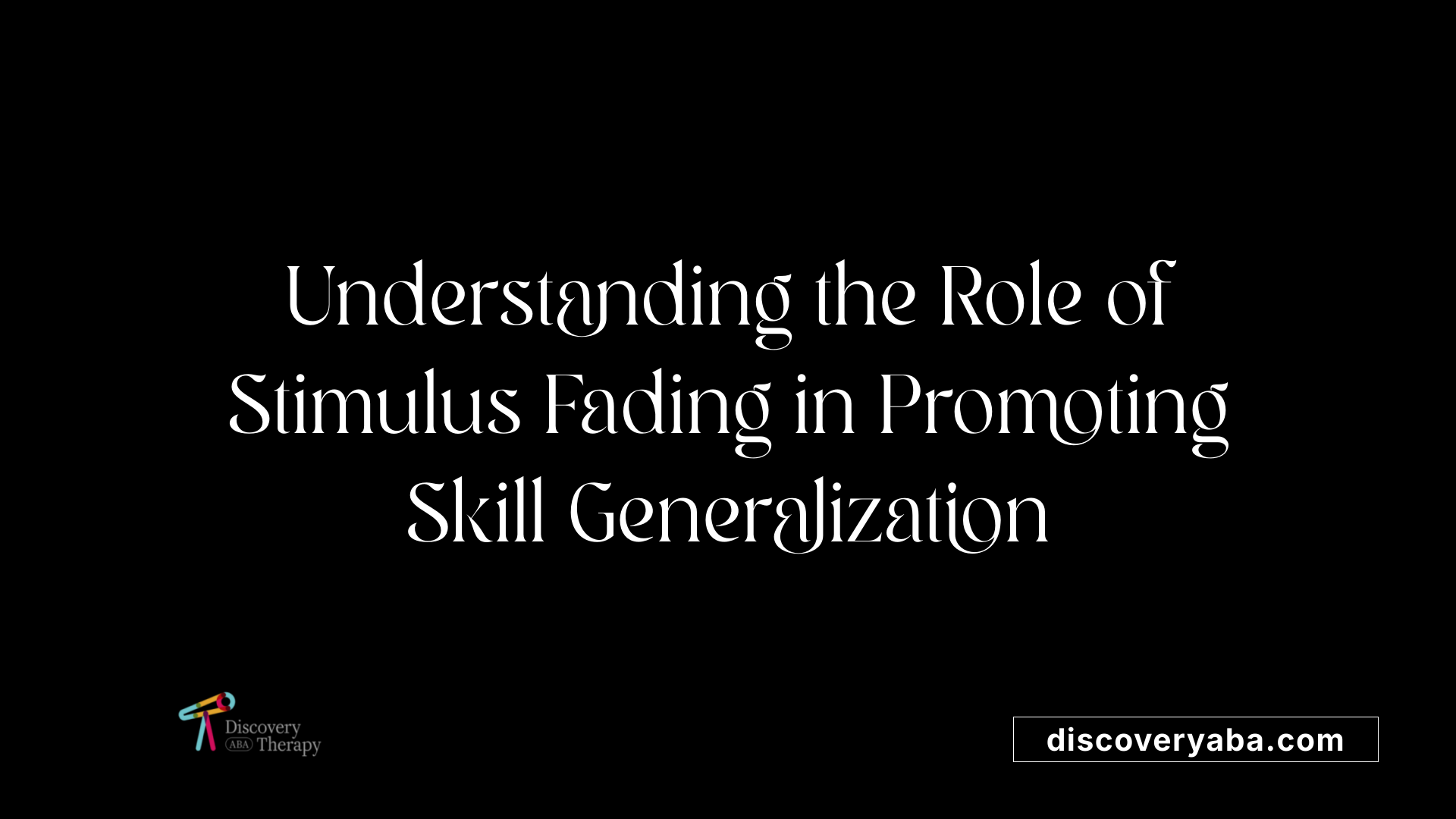
How does stimulus fading facilitate behavior change?
Stimulus fading is a fundamental technique in Applied Behavior Analysis (ABA) that promotes sustainable behavior change. It involves gradually modifying the characteristics of a stimulus—such as its intensity, size, or prominence—so that the individual responds appropriately without dependence on external prompts.
For example, a teacher might start with a brightly colored card to help a student identify a correct answer. Over time, the brightness or size of the card is systematically reduced until the student can independently respond to the natural, less prominent stimulus.
This systematic process strengthens the learner's ability to respond accurately to relevant stimuli in everyday environments, reducing reliance on external cues and prompts.
How does stimulus fading contribute to transfer of stimulus control and skill generalization?
Transfer of stimulus control occurs when a response initially triggered by prompts or artificial cues becomes controlled by natural, environmental stimuli.
Stimulus fading facilitates this transfer by gradually eliminating prompts and altering stimulus features to resemble natural cues. Techniques like prompt fading, stimulus shaping, and stimulus transformation support learners in responding accurately across diverse situations.
For instance, in teaching a child to discriminate between different foods, initial training might involve exaggerated features of preferred foods. As the child responds correctly, these features are faded in size, texture, or presentation, encouraging independent discrimination.
Through this process, skills are not only acquired but also generalized, helping individuals respond appropriately in various settings and environments.
What are the long-lasting effects of stimulus fading and its role in fostering independence?
By systematically reducing support and prompting, stimulus fading helps individuals develop confidence and autonomy. It promotes the internalization of skills, enabling learners to perform independently without external cues.
For example, in pediatric feeding interventions, gradually fading support around food textures or presentation facilitates acceptance of a wider variety of foods. Similarly, in anxiety treatment, controlled exposure to feared stimuli fosters habituation and reduces avoidance behaviors.
These techniques contribute to lasting behavioral improvements, enabling individuals to navigate daily routines and social interactions more effectively. The overall goal is to foster independence by embedding skills in natural contexts, ensuring behaviors are maintained over time and across different environments.
Conclusion: The Impact of Stimulus Fading in ABA
Stimulus fading is a versatile and essential technique in ABA that systematically reduces reliance on prompts and artificial stimuli, fostering independence and skill generalization. Its successful application across various behaviors—from discrimination training to phobia treatment—demonstrates its effectiveness and importance in behavior change. Supported by research, stimulus fading enhances stimulus control transfer and promotes lasting, functional skills, making it a cornerstone strategy in effective behavioral interventions. Consistent, systematic use of stimulus fading can significantly improve outcomes in educational, clinical, and everyday settings, empowering individuals to respond appropriately in natural environments and achieve greater autonomy.
References
- Stimulus Fading - an overview | ScienceDirect Topics
- Stimulus Fading and Response Elaboration in Differential ...
- What is Stimulus Fading in ABA? - BehaviorPREP
- Stimulus Fading - ABA Study Guide
- Understanding Stimulus Control Transfer - Apollo Behavior
- Stimulus Prompts, Response Prompts, and Fading - Section G-4
- 6e.G-8: Design and implement procedures to fade stimulus and ...
- Stimulus Fading and Differential Reinforcement for the Treatment of ...
Does Your Child Have An Autism Diagnosis?
Learn More About How ABA Therapy Can Help
Find More Articles
Contact us
North Carolina, Nevada, Utah, Virginia
New Hampshire, Maine
Arizona, Colorado, Georgia, New Mexico, Oklahoma, Texas
.avif)




